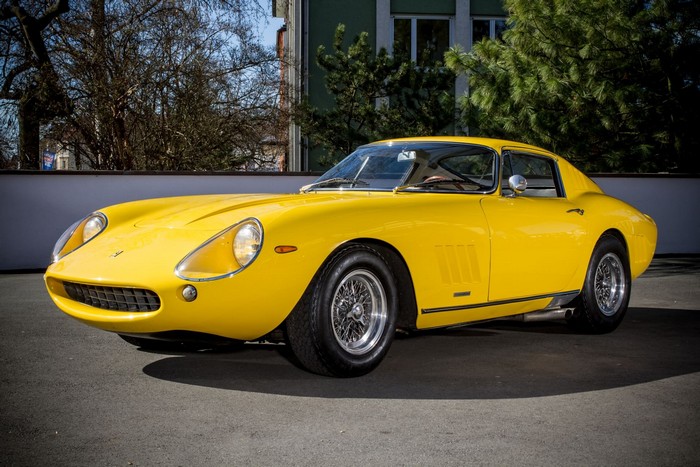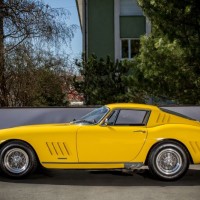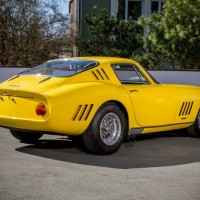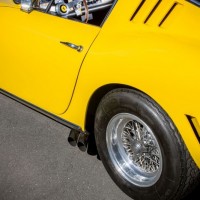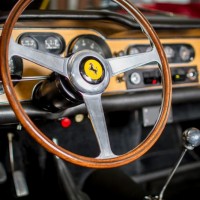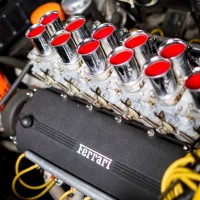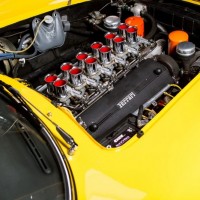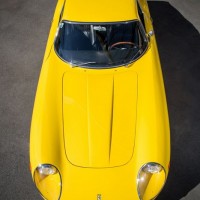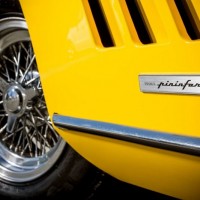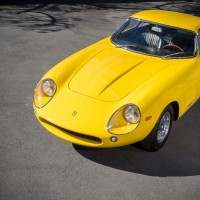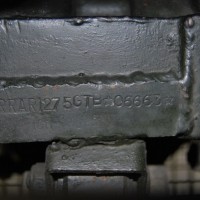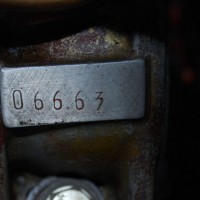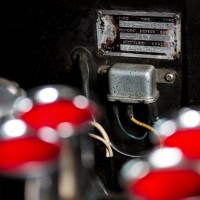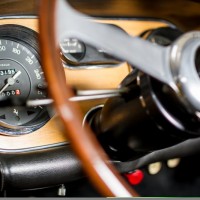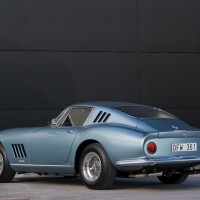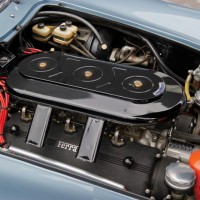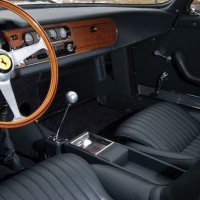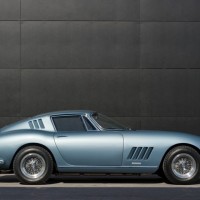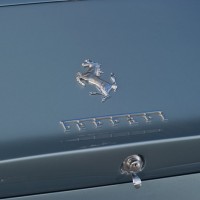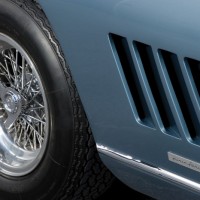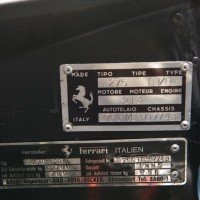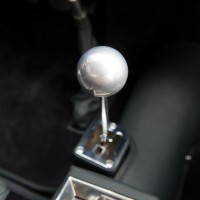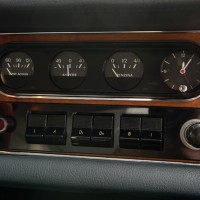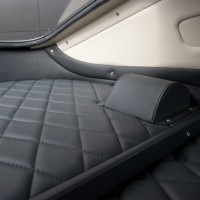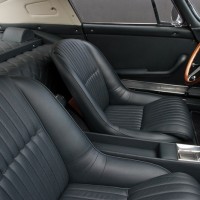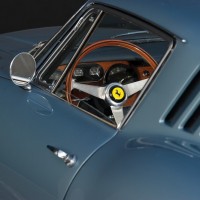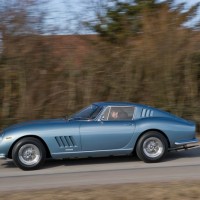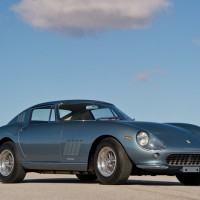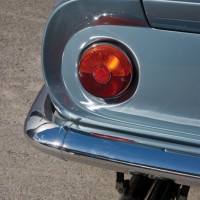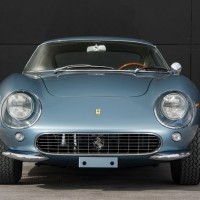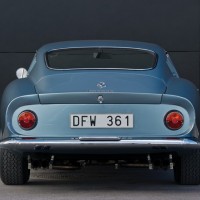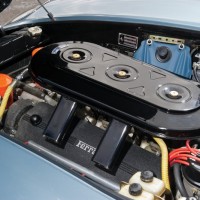1964 Ferrari 275 GTB Berlinetta
Chassis number 06663 was originally built as a short-nose model with a steel body. Factory records show that the car was originally finished in Azzurro (blue) with Pelle Nera (black leather) interior.
Less than two weeks after it was sold to its first owner, 06663 was sold again. The new owner quickly put the car to work on the hillclimb circuit. Around the end of 1966, the owner ordered a long-nose front section from Scaglietti and had it grafted on the car. Around that same time, the engine was converted from three carburetors to six carburetors and the car was resprayed white.
The car was then put back in hillclimb service, where it performed so well that it was featured in the 1967 official Ferrari yearbook.
Later, the car was sold to the U.S., repainted yellow and passed through a couple more owners before being returned to European ownership.
The vendor has reinstalled the original Abarth side exhaust and fitted the car with Borrani wire wheels. Otherwise, the car retains its hillclimb configuration. Rarer — and quicker — than a 250 GT SWB, yet considerably less expensive than a 250 GTO, the 275 GTB is a landmark model.
1964 Ferrari 275 GTB Berlinetta
This car was sent to Auto Becker for display at the Frankfurt International Motor Show of 1965. It was delivered in short-nose configuration and was finished in Azzurro (blue) with a Nero (black) interior. Sometime following the September show, 07743 was sent overseas to the United States, where it eventually wound up in California. While there, the front was modified to long-nose configuration.
Chassis 07743 passed through several other hands, and in 1999 it was sold to a well-known collector, who in 2008 commissioned Dutch-based restoration firm Hietbrink Coachbuilding to completely restore the car back to the original specifications — including the short-nose configuration and original paint scheme.
This 275 GTB remains in spectacular condition, having been used very little since its restoration. 07743 comes complete with correct Borrani wire wheels, a restoration file, a full dossier of restoration photographs, and owner’s books. Importantly, the car comes with full Ferrari Classiche certification.
In the final analysis, the 275 GTB is one of the greatest Ferraris ever built: a sophisticated, powerful, competent, high-performance berlinetta that looks as good as it runs.
SCM Analysis
Detailing
| Vehicle: | 1964 Ferrari 275 GTB Berlinetta |
| Number Produced: | 474 (all 275 GTB 2-cam variants) |
| Original List Price: | $11,500 |
| Chassis Number Location: | Right front chassis rail by top of shock mount, plate on right inner fender |
| Engine Number Location: | Right side near starter motor, back of block |
| Club Info: | Ferrari Club of America |
| Website: | http://www.ferrariclubofamerica.org |
Chassis 06663, Lot 20, sold for $1,167,977, including buyer’s premium, at Bonhams’ Spa Classic Sale on May 25, 2013. Chassis 07743, Lot 105, sold for $1,456,000, including buyer’s premium, at RM’s Villa Erba Auction on May 25, 2013.
Two 275 GTBs are auctioned on the same day, but one sells for $1,456,000 and the other for $1,167,977. We have a $288,023 difference between two cars that were nearly identical when they left the factory. They both have a good — if not impressive — history and were both restored to a high level.
Is the Ferrari market in this much disarray or is there another reason for the price gap?
First, a little history:
The original 1964 275 GTB configuration is now known as the short nose. The design proved to be somewhat unstable at high speed, and it was superseded with what is now called the long-nose model. The long nose has a noticeably longer snout sticking out in front of the headlights. The long-nose version also addressed the 275 GTB’s problems of limited rear visibility and limited trunk room.
The rear-window area was larger and the trunk hinges were moved outside of the car — rather than protruding into the trunk. The long nose and larger rear window aren’t easy to identify, unless you’re familiar with the other versions. The external chrome trunk hinges are the car spotter’s clue to identifying the long-nose cars.
The original short-nose and the long-nose 275 GTBs are powered with a 280-hp, 3.3-liter, 2-cam V12 engine. A 300-hp, 6-carburetor version was offered as an option. The 275 GTB was the first production Ferrari to feature a rear-mounted transaxle and independent rear suspension. Later, a 4-cam, 6-carburetor version called a 275 GTB/4 replaced the 2-cam model. A bulge down the center of the hood and an upholstered dash is the spotter’s clue that they’re looking at a 4-cam car.
The 275 GTBs bodies were offered in alloy or steel. Many 275 GTBs were raced, and the factory built a few competition specials. Customer competition models might have extra vents, outside filler caps, bumper delete and competition wire wheels. Factory team cars could be quite exotic, with special lightweight bodywork and mechanical components. Comp features could be ordered on a production car. It is important to know if a 275 GTB with comp features was built that way or modified afterward.
Won by a short nose
If you follow Ferraris, you probably already know the ending to our $288k mystery.
In real estate the mantra is “location, location, location.” The Ferrari mantra is “originality, originality, originality.”
Chassis 06663 (Bonhams/Spa) had an admirable competition history, but that wasn’t enough to compensate for its modifications. The 6-carb configuration and the nose extension were legitimate improvements. They made the car faster and handle better. Removing the bumpers and adding vents behind the rear wheels made the car lighter and brake better. Yes, 06663 is one badass 275. It looks fast standing still — and probably runs as good as it looks. But the Ferrari market likes originality, and this Ferrari is far from original.
On the other hand, chassis 07743 (RM/Villa Erba) also had a nose job, but it’s been painstakingly restored back to its original configuration. The authenticity of the restoration is verified with a coveted full Ferrari Classiche certification. This car looks authentic to when it rolled out of the factory in 1965, and has the Ferrari stamp of approval to prove it.
People like to build hot rods, but they don’t like to buy them. There are obvious exceptions to this, but few exist in the Ferrari world. Someone who plunks down a million dollars on a car wants some reassurance that the greatest number of possible buyers will want it down the line.
Chassis 07743 is a blue-chip car that is negotiable to nearly anyone who wants a 275. Chassis 06663 is a lot of car — and a great piece of history — but its real appeal is limited to someone looking for an event car or a bargain.
A second chance?
The 275 market has been explosive. Not much more than a year ago, a short-nose 275 GTB would have been well under a million dollars. Now it appears $1,400,000 for 07743 is not out of line.
All this makes 06663 the real deal here. I personally would like to see it kept in its as-raced configuration. But if a little bodywork and an Italian blessing can make 07743 a virgin again, there’s no reason 06663 couldn’t follow its lead. $200,000 should be enough to put 06663 back to stock configuration. Add in the competition history, and 06663 is a money maker. ?
(Introductory descriptions courtesy of Bonhams and RM Auctions.)
